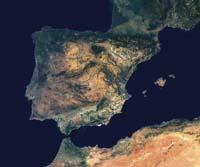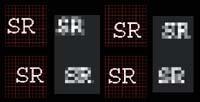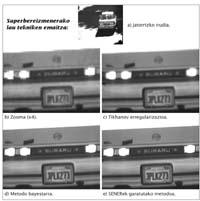High definition images at high speed
2006/02/01 Imaz Amiano, Eneko - Elhuyar Zientziaren Komunikazioa Iturria: Elhuyar aldizkaria

When HD images are needed, there are two options: using good cameras or treating less good images by computer. However, even if the camera is very good, the quality of the images obtained may not be enough.
The first trend of those who do not work with images, placed in front of the computer, is usually to increase the photo, zoom. This technique is very limited, it can increase a bit rather, but by increasing twice, for example, quality and resolution decrease dramatically. Therefore, it is advisable to use special programs to achieve good results, both in photos and videos.
Mandatory urinals
Computer images are actually formed by squares called pixels that create an array. Pixels contain information about the color and intensity of this area of the image. Therefore, the more pixels, the smaller these will be and, therefore, more information about the image, with better resolution. And the higher the resolution, the more possibilities to work and expand.
When we zoom in on the computer, the pixels increase but are not added, the amount of information is the same, but the image surface is larger. This makes the image fade or pixele. It is more appropriate to increase the number of pixels, but of course, new pixels must be given new and adequate information. If they are assigned the same information as the pre-existing pixels, the image will blur again.
Superresolution
Methods that incorporate pixels and new information for them are called superresolution methods. They are programs that reconstruct images in low definition and improve their resolution, and are used in satellite images, in the treatment of images obtained through telescopes, microscopes, security cameras or infrared cameras, in the recovery of old films, in digital technology, etc.

Systems based on mathematical calculations are the most widely used superresolution methods. These systems or methods perform probabilistic calculations to know how to integrate the new information of the added pixels and thereby create a new image.
The most commonly used probability methods are Bayesian analyses. The results are very good, but they are usually quite slow: it takes 1 or 2 minutes to try the video for a second. Another relatively new method. It is a neural network-based superseparation system that works 100 or 200 times faster, almost in real time.
However, all superresolution programs, both probabilistic and neuronal, divide the work into two phases. In the first phase new pixels are created to which new information is assigned. For this, video fragments or still image sequences are required. In a second phase, they use this information to reconstruct the image with better quality.
Neural networks
Limited to the neural network method, in a first phase, the system generates a new matrix based on the network or pixel matrix of the video image. Specifically, it generates an array of 16 new pixels per original pixel.
Then use the motion of the objects in the images to attribute information to the new pixels. The movement can be the displacement of the object itself, from the frame of a video to the frame or in a photographic sequence. However, if the object is standing, the system has a movement as small as the vibration of the camera itself.

However, when moving the image, on the one hand it passes through the new pixels, generating information for these new pixels. On the other hand, the movement creates new angles between camera and object, which the system uses to obtain new information: it improves the definition of borders, colors, tones, etc. thanks to new angles or views.
This first phase is carried out by the new program based on neural networks using standard methods.
In a second phase, the program unifies all the information and remakes the image with better resolution. So far the systems used mathematical estimates to unify information and calculate the most likely image based on it, while neural networks do not need calculation as they are preformed.
Living beings as an example
Programs that work with neural networks are systems based on artificial intelligence. The neurons of these networks are simple simulations of the neurons of living beings, but all of them grouped in a network can generate computer models capable of performing tasks of great complexity.
The main characteristic of this type of system is its learning capacity and, in this case, its training in the treatment of images.

Training is very similar to what people do for many things. First, a good quality image or resolution is introduced to the system, followed by several low-resolution examples of the same image. With them, the program is hindered over and over again from every poor image, that is, it is advanced from bad to good.
The program adjusts several parameters to reach the marked target and memorizes these settings. So, by finding specific parameters, you know what and how much you have to change.
It takes about 6 hours for proper training. He has learned how to treat low-definition images and, henceforth, knows what and how to treat them in each case. It will always follow the same steps: it will place the image to be treated in the new pixel matrix and, thanks to the movement, it will provide new pixels with new information through the usual techniques, and later the neuronal network will unify all the information and reconstruct the image, based on the forms of action and the parameter settings that it has memorized.
The system based on neural networks does not require mathematical calculation, so it can work on a blow. There he earns time.
This new superresolution system, developed at SENER in Getxo, is already on the market. However, we don't think it's easy to get. Despite the fact that a car and a ferry appear in the examples, they have mainly gone to the market for the treatment of images recorded by satellite, as reported by the project manager, Carlos Miravet.




